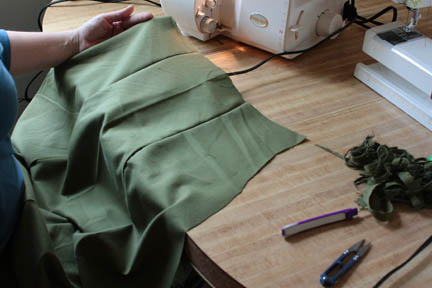
This is my big, red, muff. I think the muff is one of my favorite winter accessories. Gloves and mittens just don’t do it for me. With my muff I can keep my hands warm, and when it’s really cold combine it with a pair of gloves and be extremely cozy. They’re also great for holding hands! With your hand in one end, and theirs in the other you can guide your loved one and share the warmth.
Today I’m going to share a simple step-by-step tutorial to make a simple faux fur muff, as well as a few tips for working with the material. This is a very quick and easy project that you should be able to complete easily in under an hour, doesn’t require any tricky seams (just straight stitching) and can be sewn simply by hand if you like.
The first step is always to gather your supplies.

You will need your faux fur (availabe at most fabric stores by the yard or by the piece, especially during the colder seasons). Be sure to pick one that feels good to you. Quality can vary widely from something scratchy and obviously fake to some that could almost pass as real. I’m choosing this fun bright red for this tutorial.
Besides the fur you will need basic sewing supplies; scissors, something to measure with, something to mark with (chalk or a marker), thread, and a sewing machine (or a needle).
Before we get cutting into that fur I want to share a couple of tips to get a nice cut with less mess. Cutting your faux fur is going to be messy. There’s just no way around it, because when you cut into the fur hundreds or thousands of those little “hairs” are going to come out and scatter. Don’t cut your fur on carpeting (you will be vacuuming for months), and consider wearing clothing that the fur won’t stick to. If you don’t want to spend a lot of quality time with your lint roller you will want to cut your fur on wood, linoleum, or tile floors that can be swept easily. You might even consider doing your cutting outside, and let your furry fuzz become padding for a lucky bird’s nest.

Now let’s take a look at your fur. In the image above we are looking at the back side of the fabric. You can see that the back is a knit fabric. Fur fabric has a “pile” which means that it has lays a certain way (this is called the nap). In this image I have marked the direction of the nap with a blue arrow, the top of the nap with green, and the bottom of the nap with purple. Cutting parralell to the blue line, or with the nap, is pretty easy and won’t produce much mess, but when you must cut across the nap there is the possibility of a HUGE mess.
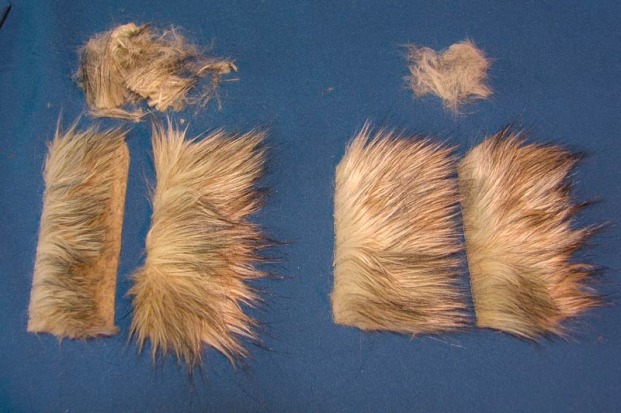
This photo shows two sample pieces of faux fur that have been cut across the nap and their resulting piles of fluff. On the left, the fur has been cut the same way you would cut any thick fabric, cutting straight through the fur and the backing. You can see that the edges on one side of the cut are ragged and that the fluff ball is about 3 or 4 times bigger than on the right. If that much fur came off of a piece that is just a few inches across, you can imagine how much fur will fly when you cut a piece for a larger project! The piece on the right was cut carefully by slipping the edge of the scissors up into the fur, and cutting just the backing with little “snip-snip” cuts.
 Here’s my attempt at a cutaway view of this technique. The tip of the scissors should stay against the backing the whole time, just sliding through the fur, while the underside of the scissors move up and down. It will take a little bit longer, but trust me, the time spent cutting this way will save you hours of fur clean-up afterwards.
Here’s my attempt at a cutaway view of this technique. The tip of the scissors should stay against the backing the whole time, just sliding through the fur, while the underside of the scissors move up and down. It will take a little bit longer, but trust me, the time spent cutting this way will save you hours of fur clean-up afterwards.

Now that you know a little bit more about faux fur and how to cut it, let’s cut our fur into a piece that is 16 inches by 24 inches.
My 16 inch side goes with the grain, and my 24 inch side is cut against the grain. This will produce a muff that will have the nap of the fur wrapping around the muff. Cutting it the other way will have the fur pointing to one side.
With you piece cut we will begin to sew. Fold your fur in half, with the right sides together. Match up your 16 inch sides and sew a seam along the edge to make a tube. Turn it right side out.


Next, We will begin to turn the tube back to inside out, but stop halfway.

Start like this, and continue until the two raw edges of your tube are lined up. If you notice that, like my tube, your ends are a litte uneven just trim it up. Fur loves to slip and slide under the presser foot!
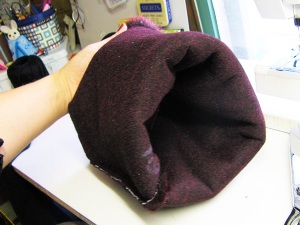
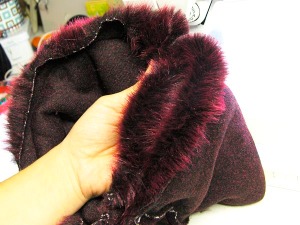
This is how it should look with the raw edges together, right sides inside. Next, sew around the tube, at the raw edges, but leave a generous hole to turn through.

Finally, Turn the tube right side out and hand stitch your turning hole closed. Use whatever stitch you like. The pile of the fur will hide the stitches, so it doesn’t even have to be perfect or pretty. Just get that hole securely closed. Now the final shape of your muff is complete. I like to turn the tube to hide the first seam we sewed into the inside of the muff. To free the fur that is trapped in the seam, just use a needle or other small, pointed object and run it along the folded down hairs. It should be easy for you to release most of them easily, then fluff with your hands to help hide the seam.

And that is the end of the tutorial. Easy, wasn’t it? Enjoy your muff for it’s fabulous ability to keep your hands warm, and as a way to honor the elegant fashions of the past.















































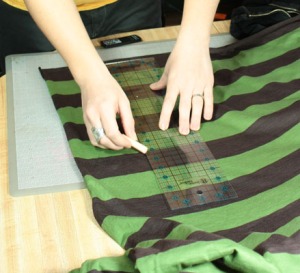






 Repeat the process with your other rectangle of fabric on the other sleeve, and that’s it!
Repeat the process with your other rectangle of fabric on the other sleeve, and that’s it!























